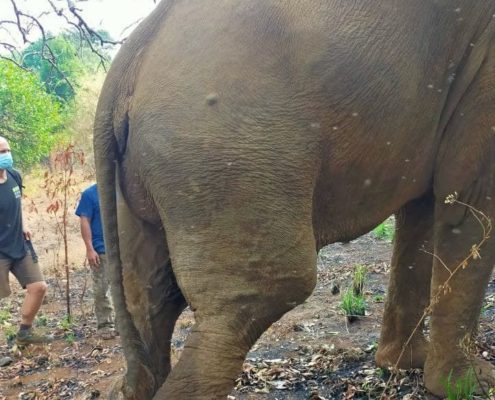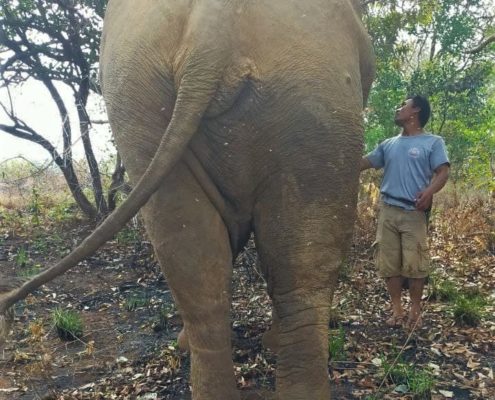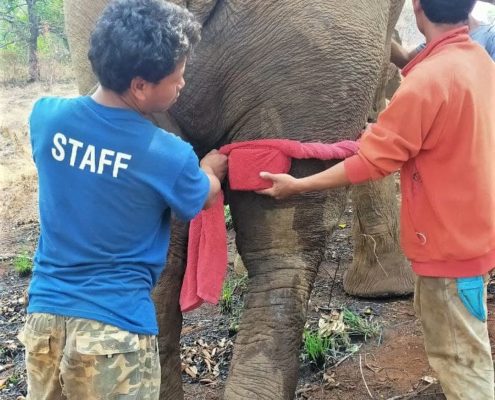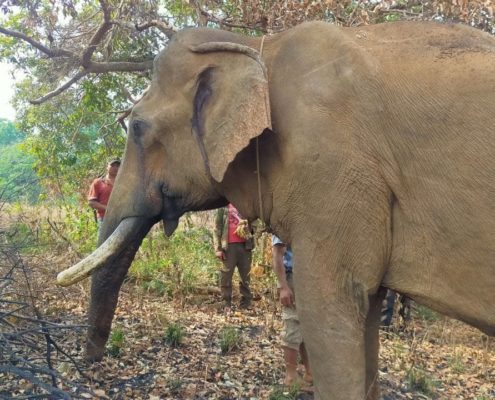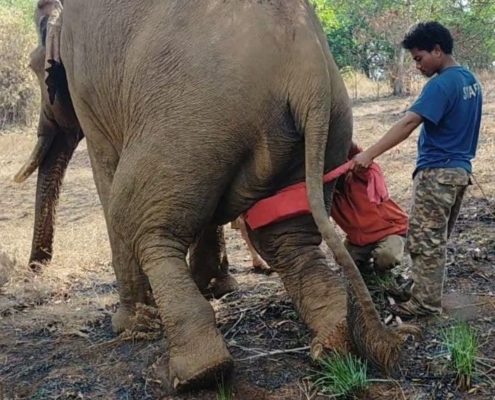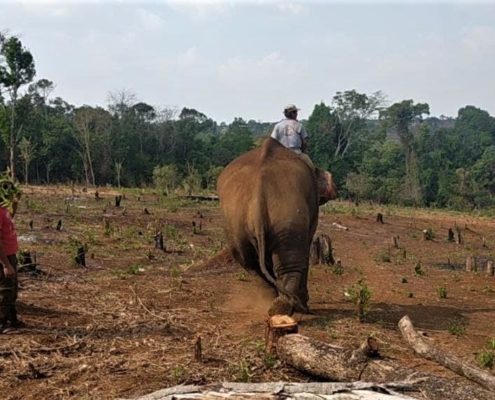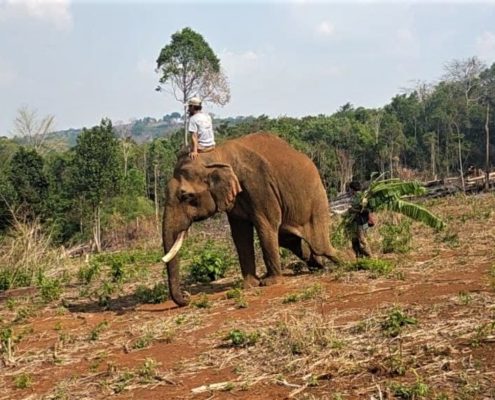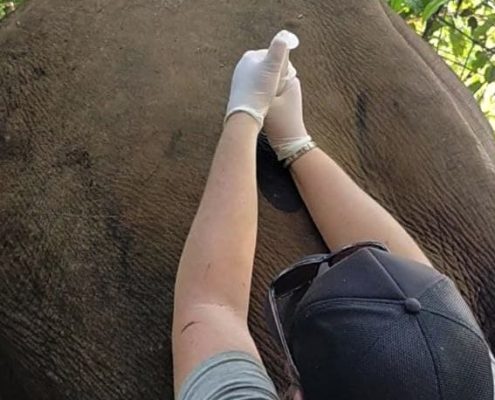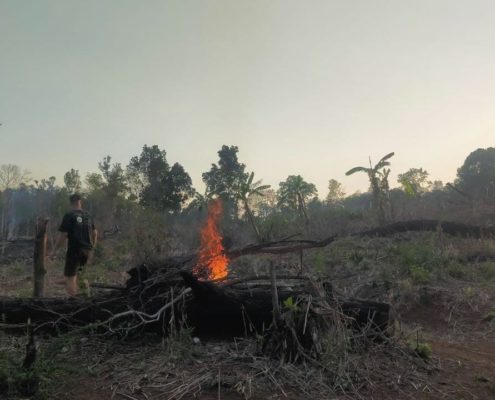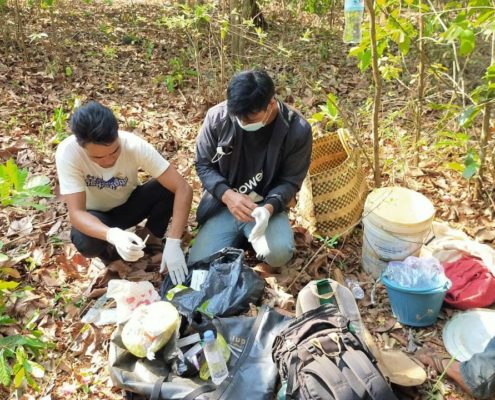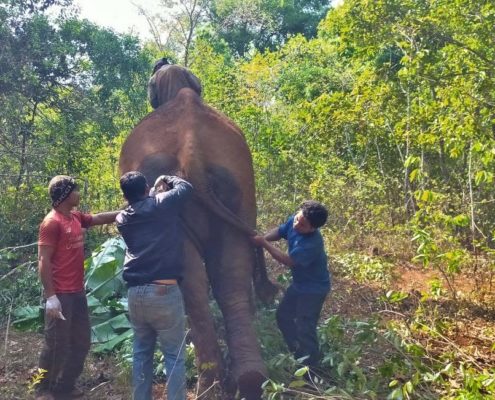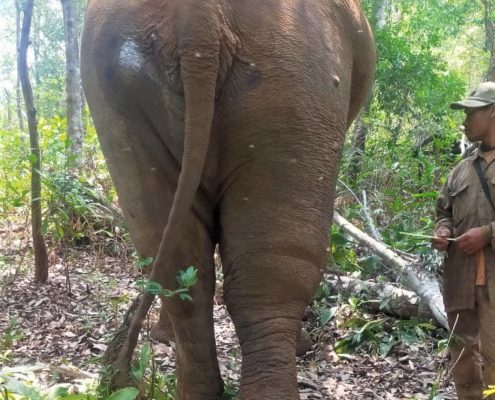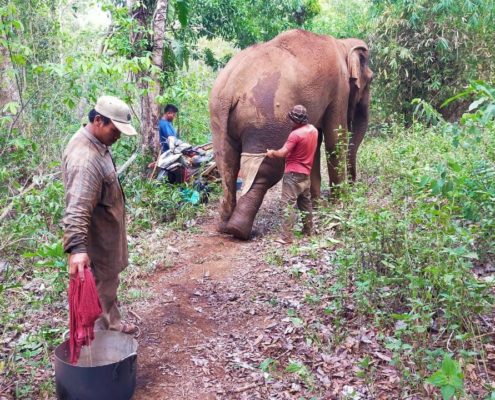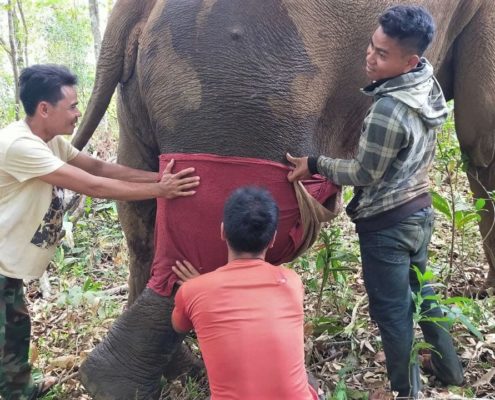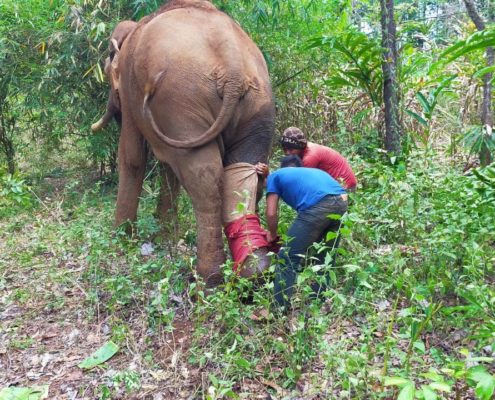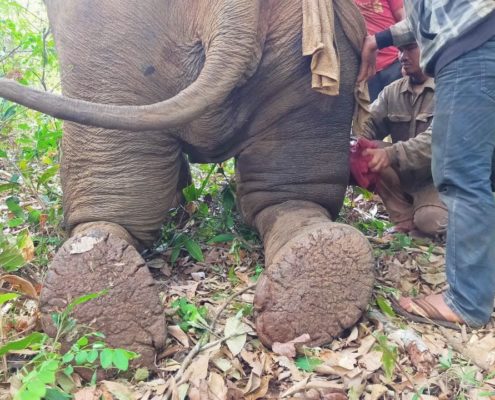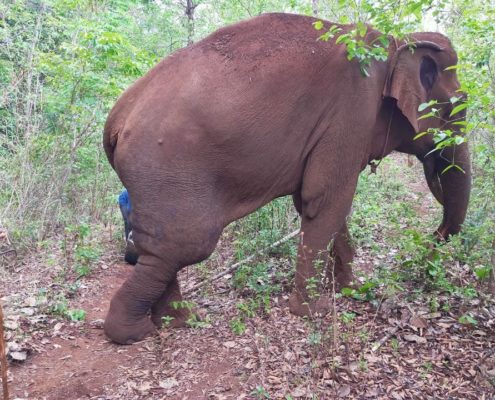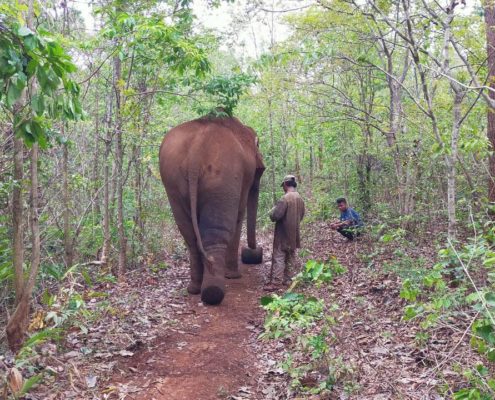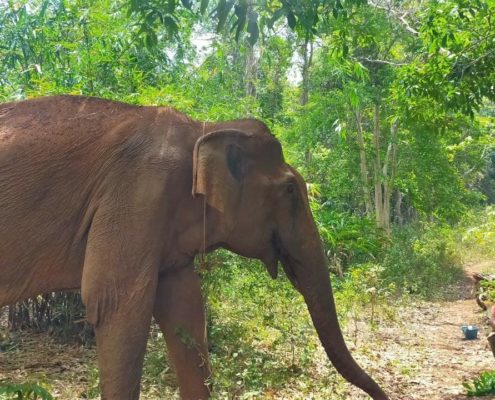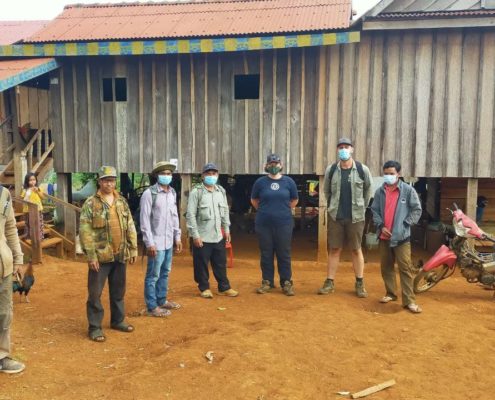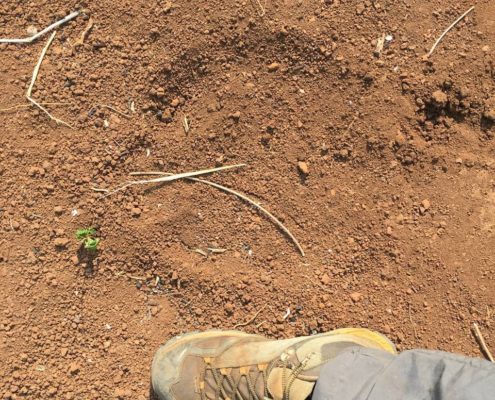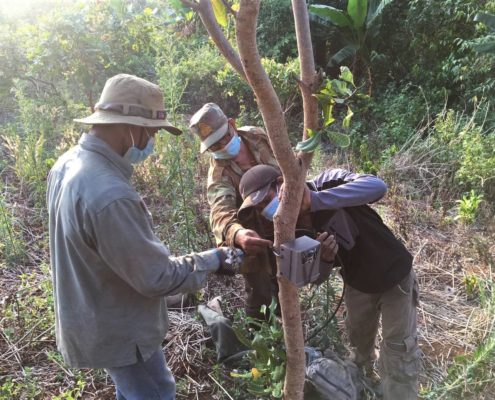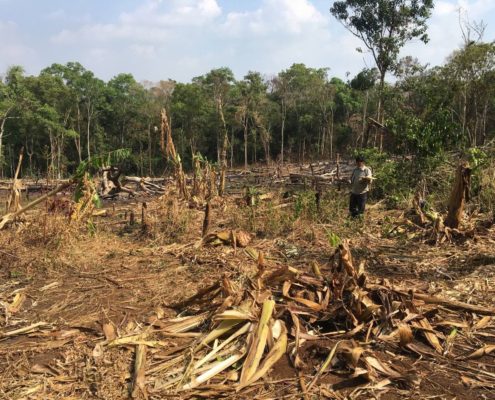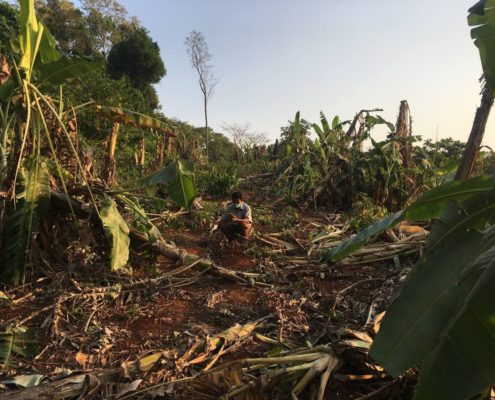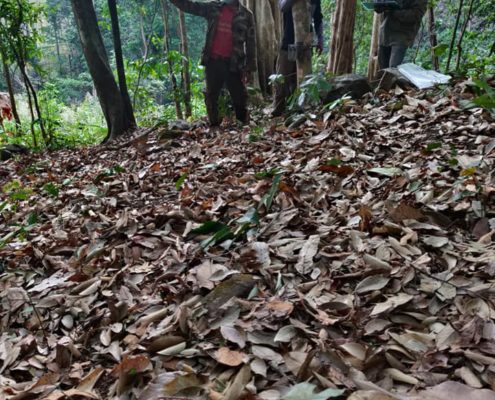EVP Blog – Wild Elephants In Our Backyard
Return of the wild elephant and Bulls collide
As I sit here drinking my third cup of coffee this morning, I’m trying to figure out how to record all that has happened again in the last week. It’s a bit of a long read, but it’s been one hell of a week.
Following our wild elephant drama last year…..and another long stressful year on and the drama unfolds again. Over the last 12 months, we have seen deforestation all around us. Even more worryingly, the cutting is happening further into the protected forest and in the wild elephants main migration areas. So when we heard there were sightings of some wild elephants along the big river system at the back of the project in the beginning of March, we actually moved all our eles closer to the EVP basecamp and into our northern valley. We didn’t want poor Gee Nowl getting stressed and coming into contact with wild eles again.
Last Sunday, things changed. The mahouts and community heard trumpeting and screaming at 6 a.m. and rushed out to find the source of the commotion. Unfortunately, the noise was coming from our big boy Hen, who was on the edge of the EVP area as close as we could get him. It seems again a lone wild bull wandered further into the EVP area this year. We believe this is the same tuskless male that was here last year and ran off with Pearl. When bulls meet in the wild, there is usually a fight for territory, protection of their herds or resources.
So again this wild bull is trying to push into the EVP area and came into contact with Hen. There must have been a massive fight and in the process Hen’s back leg was badly injured. By the time we grabbed medicine and the emergency kit from town and got out there, the boys had managed to get him about 200m away from where the wild bull attacked him, risking their lives to protect Hen. They made noise, banged sticks and the wild elephant retreated back up the next ridge.
Sunday was touch and go. We had to try and get Hen further away from the wild bull, in a safe, open area so we could protect him. He also needed treatment and water. It was clear Hen was very injured, and initially out observations pointed towards a broken leg or a dislocation. We treated him briefly at this site and we were all on edge, as the wild bull could come bursting out of the forest at any moment. Painstakingly the team then helped Hen move closer to our village, and he made it to the river. He could not move his back leg, and had to crouch forward and hop, dragging his leg. We lit fires around his location for the night and hoped that the wild elephant would not follow him here. This was a horrible day, and each day this week has been up and down.
Hen’s leg is still extremely swollen, but has been showing signs of improvement each day. Without a portable x-ray machine out here it’s hard to know for sure, but we now believe it’s not a break but some pretty bad knee damage. With international veterinary advice, he has been getting some pretty strong pain meds and also anti-inflammatories. The team has been giving him hot towel compresses three times a day. The swelling is changing location as the week goes on, which is a good thing. He is gradually starting to slowly move around the forest, and is still eating pretty well. During this stressful week the mahouts and vet team all are doing a fantastic job and we are all working many hours overtime. Recovery is going to be a long process, but now it’s a matter of rest and time will tell.
More Wild Elephants!
That’s the second part of the story. For the first time, that the community can remember, wild female eles have crossed the big river boundary. So this year it’s not only the lone bull but a herd of eles moving through the community forest and the EVP main valley!
While treating Hen, we have also been working with partners from Wildlife Conservation Society (WCS) and the Department of Environment rangers from the protected area, to track the herd. We believe there are two small female family groups, with some young elephants. There is also a big beautiful tusker moving along after the female group. We have put out camera traps with the WCS human-wildlife coexistence team, hoping to gather some information on these elephants and are trying to keep an eye on where they are moving. We have moved our two elephants Sambo and Ruby close to the village to protect them, and the others are all on the other side of the sanctuary, as far away as possible.
Unfortunately these herds are coming out of the forest of the protected areas and the EVP at night time and raiding farms in the surrounding areas, which is making a lot of people quite angry. This is the first year that these elephants have been crop raiding in this area and this anger will only increase. These newly cleared farms and areas where the elephants normally migrate through are being cleared and they are being pushed to go further into areas they don’t usually go. So it’s not the eles’ fault. But the anger will remain.
Why is this Happening?
When joining the team here, nearly 10 years ago, it was my dream to see our captive elephants wild cousins in their natural habitat. We also wanted to promote the contribution captive elephant sanctuaries can have for species relevant conservation. Over the years we have been focusing on forest conservation, not only for the community forest; our sanctuary elephants’ habitat, but also as a broader contribution to the protection of the 300,000 hectare protected area called the Keo Seima Wildlife Sanctuary (KSWS), which we sit on the boundary of. By funding ranger teams, community forest protection and partnering with conservation organisations for research and more, we are trying to help create the EVP sanctuary and surrounding forest as another buffer zone for the protected area and all its inhabitants. That is the theory anyway.
Unfortunately this park has been taking a beating and is battling forest cutting, encroachments, small scale land grabbing and large scale developments. We have seen the entire forested area of Snoul Wildlife Sanctuary, adjacent to the southern side of KSWS, disappear, leading to its cancellation. As a result we have seen emergencies unfold, such as a herd of eleven wild elephants getting stuck in a mud pit on a recently cleared land area in 2017. I did however get my first glimpse of wild elephants then, as we were called in to help rescue these elephants. Not an ideal first encounter, but one that brought home the realities that these remaining 100 or so wild elephants in the KSWS park are facing. As the years have passed, I have seen a few more wild elephants, been called on other emergencies, but have heard many more stories. Stories of elephants being seen more and more in community farms, on the edge of the park, sadly to their detriment. We saw one of the first elephants shot in a farm on the south of the park in the beginning of 2019.
These land clearings, through expanding local communities or larger developments, are cutting down the options for the wild elephants. Their normal migration routes are being disrupted. They return to an area they moved through last year, only to find 10 new farms with fences all around. It’s unfortunately an all too common a problem across all of the Asian elephants’ home range of countries.
Over the last few years, I have also seen the stress start to wear on many of our local staff and community members, as their land is also put under more and more pressure. Supporting the community to achieve their Indigenous Communal Land Title in 2015 was a major accomplishment, as a indigenous community they now legally own 1500 hectares of land. This year they have also been allocated a 400 hectare community protected area within the border area of their land and KSWS to manage the resources for their community. There are good things happening. However, everywhere outside of these areas are under extreme pressure.
Speaking to many members of the community, they say in living memory they have not really had wild herds of elephants pass through these community lands. They had always stayed within the deeper forest areas, walking along a major river area behind the community and the EVP sanctuary. We have always heard when the eles are moving along that big river system, but they generally kept going. However, as we saw last year and now this week, this has all changed.
The landscape these wild elephants now live in is changing rapidly every year. How they navigate the future is very unclear.
Where do we go from here?
Some big questions and no answers this week, but our mission remains the same, help captive elephants return to the forest, try to protect that forest for them, the community and the habitat of wild elephants. What is clear this week is that our elephants, the wild elephants and the forest’s future are all wrapped up together, and we need to find a way to co-exist.
Our focus is, at this moment, helping Hen each day and hoping that he can recover. Sadly this is just one more added stress on top of a very stressful year. But we must continue, all for the elephants!
We will keep you updated on our big boy and how we are all doing.
I want to thank all our supporters, sponsors, donors, family and friends, you always keep us going during times like these.
If you can help in anyway, at the moment we need quick funds for medicine for Hen and the increased fruits we are buying for him, please contribute to the EVP 2021 Survival Fund here – https://elephantvalleyproject.org/donations/
Thanks
Jemma Bullock
ELIE/EVP Manager
Article on wild elephants in Keo Siema Wildlife Sanctuary this week –
